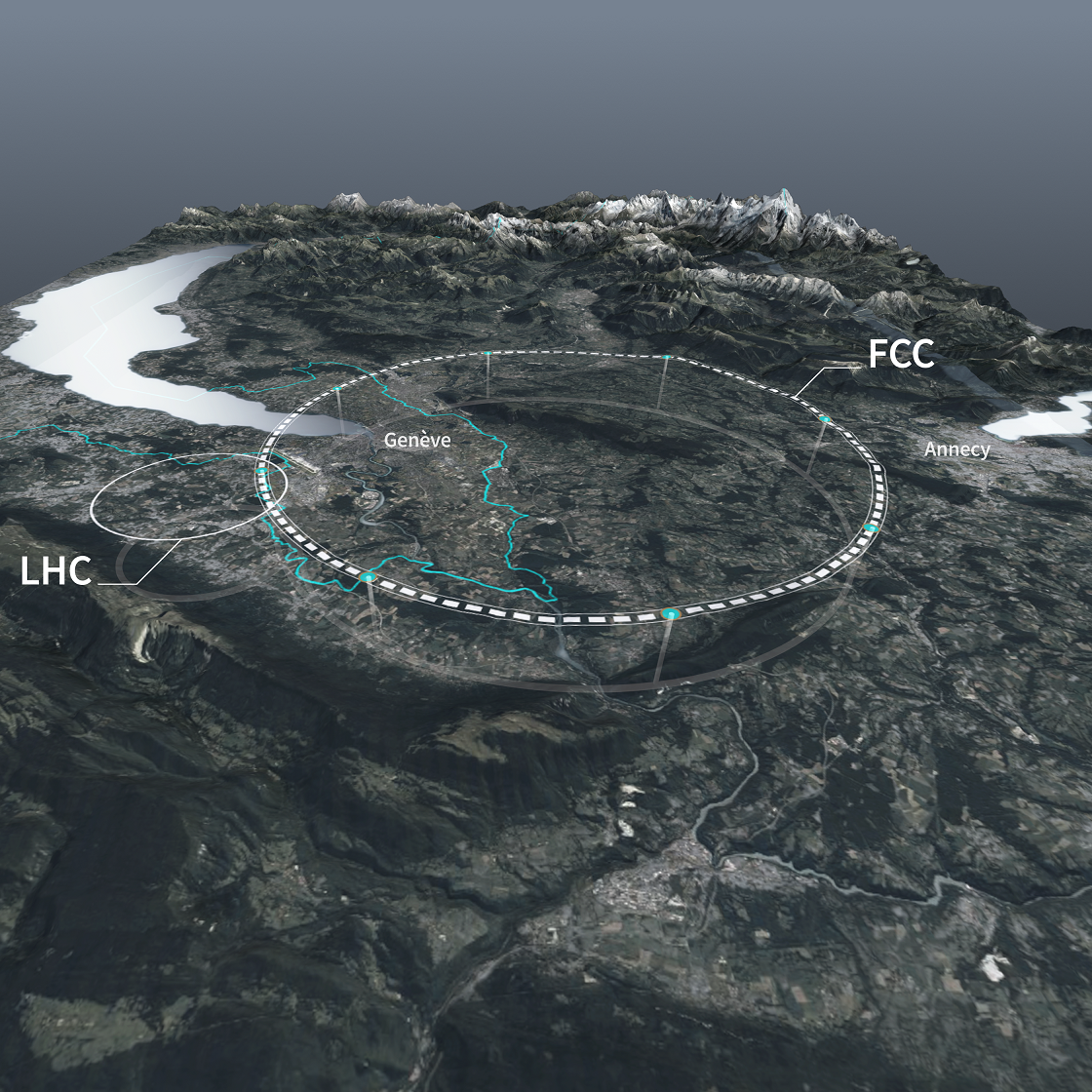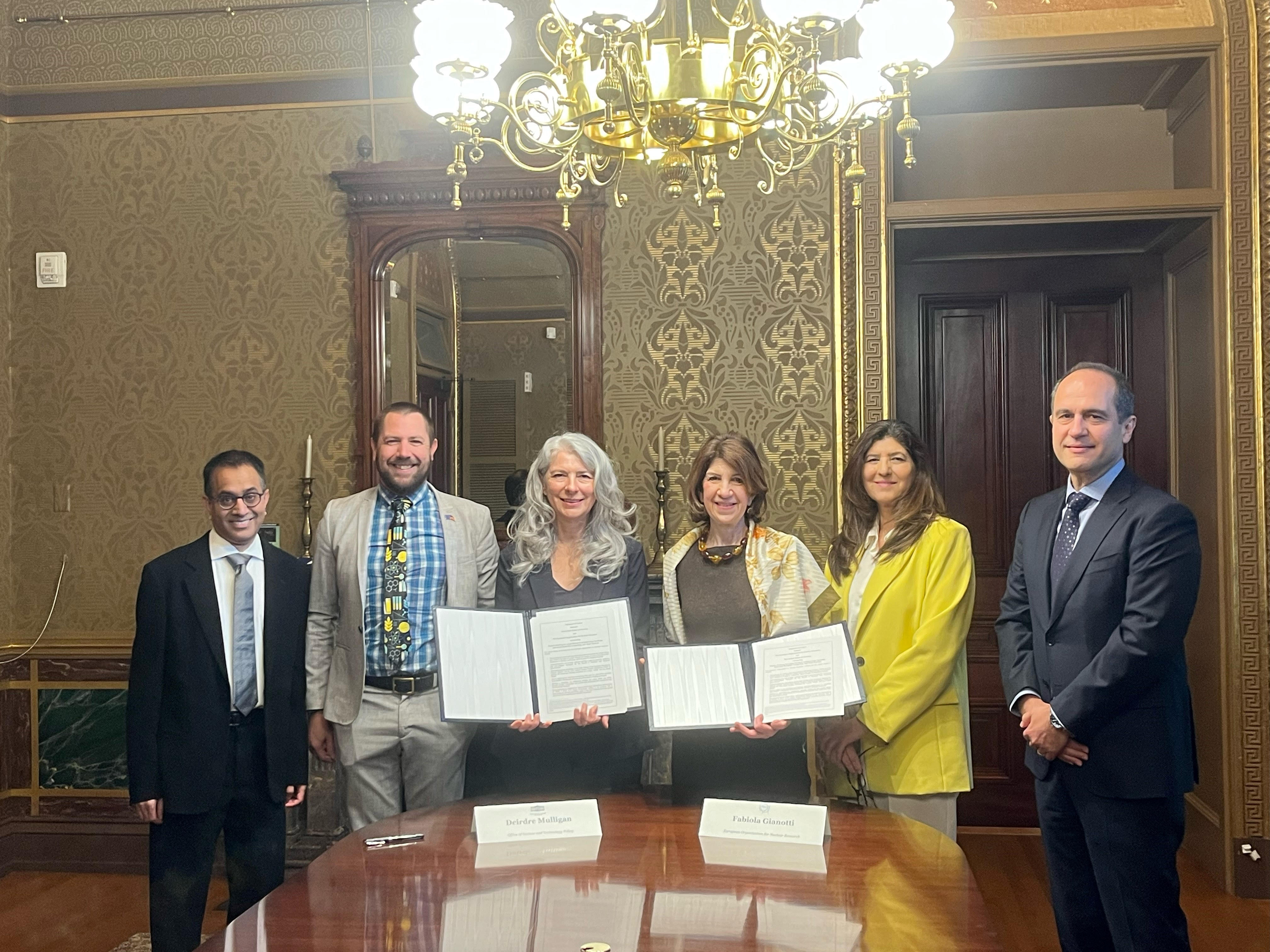On April 26, 2024, a joint “Statement of Intent between the United States of America and the European Organization for Nuclear Research (CERN) concerning Future Planning for Large Research Infrastructure Facilities, Advanced Scientific Computing, and Open Science” was signed at The White House. The US-CERN SOI was signed by Deirdre Mulligan, The White House Principal Deputy Chief Technology Officer, and Fabiola Gianotti, the CERN Director-General. Among other topics, the SOI expresses an intention by the United States to collaborate on a future FCC Higgs Factory, the “Future Circular Collider”, should the CERN Member States determine the project feasible.  The planned FCC
The planned FCC
University of Maryland Professor Sarah Eno has played a leading role in establishing US participation in the physics and detectors of the FCC. Appointed by CERN in 2020 as one of two US representative to the “physics, detector, and experiments” executive committee (with Dmitri Denisov of Brookhaven National Laboratory) Eno spearheaded physics input to the decadal planning process for particle physics, known as the P5 process. The resulting white paper summarized the exciting physics potential of this facility. In the resulting P5 report, US participation in an offshore Higgs factory was recommended. Recently Eno presented the status of US involvement at the FCC workshop in Annecy, France. With this announcement, the US will start its formal participation in the development of this international facility.
 Photo from the signing showing from left-to-right: Abid Patwa (DOE), Chris Marcum (The White House OMB and Open Science Point), Deidre Mulligan (The White House PDCTO), Fabiola Gianotti (CERN DG), Rahima Kandahari (US State Department Deputy Assistant Secretary for Science, Technology, and Space Affairs), and Saul Gonzalez (NSF).The FCC is planned to be a circular particle accelerator with a circumference around 91 km. In its first phase, it would collide electrons and positrons with center-of-mass energies and beam intensities that allow collection of the entire sample of the previous LEP electron-positron collider’s Z bosons in three minutes, as well as large samples of W bosons, top quarks, and Higgs particles. Civil construction could begin in the mid 2030s, with data taking in the 2040s. The accelerator would be located around Geneva, Switzerland, in a tunnel passing near the Jura mountains and under Lake Geneva. As part of its studies of the Higgs boson, the FCC will study potential connections between it and dark matter, and search for influence of new massive particles and other new physics on its decay properties. In the future, the same tunnel could house a proton-proton collider similar to the LHC, but with a center-of-mass energy seven times higher.
Photo from the signing showing from left-to-right: Abid Patwa (DOE), Chris Marcum (The White House OMB and Open Science Point), Deidre Mulligan (The White House PDCTO), Fabiola Gianotti (CERN DG), Rahima Kandahari (US State Department Deputy Assistant Secretary for Science, Technology, and Space Affairs), and Saul Gonzalez (NSF).The FCC is planned to be a circular particle accelerator with a circumference around 91 km. In its first phase, it would collide electrons and positrons with center-of-mass energies and beam intensities that allow collection of the entire sample of the previous LEP electron-positron collider’s Z bosons in three minutes, as well as large samples of W bosons, top quarks, and Higgs particles. Civil construction could begin in the mid 2030s, with data taking in the 2040s. The accelerator would be located around Geneva, Switzerland, in a tunnel passing near the Jura mountains and under Lake Geneva. As part of its studies of the Higgs boson, the FCC will study potential connections between it and dark matter, and search for influence of new massive particles and other new physics on its decay properties. In the future, the same tunnel could house a proton-proton collider similar to the LHC, but with a center-of-mass energy seven times higher.
Maryland has had an impactful participation in the effort. Besides Eno’s participation in the PED executive committee, UMD is the lead institution in a plan for a new type of electromagnetic calorimeter for the FCC detectors. Assistant Professor Chris Palmer has also involved undergraduate students taking PHYS441 in studies of its potential physics impact, which were presented at the second annual US FCC meeting at MIT.
See the Statement of Intent here and the U.S. Department of State announcement here.
 Attendees at the 7th FCC physics workshop in Annecy France (https://indico.cern.ch/event/1307378/), including Professor Sarah Eno
Attendees at the 7th FCC physics workshop in Annecy France (https://indico.cern.ch/event/1307378/), including Professor Sarah Eno